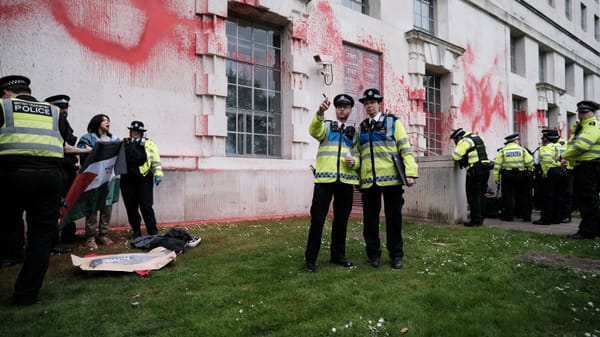If I am only for myself, who am I? Professor David Feldman on the Jerusalem Declaration on Antisemitism
A new document attempts to put right what the IHRA got wrong. Vashti interviews one of its authors.

Of the many antisemitic crimes of which Jeremy Corbyn was charged during his tenure as Labour leader, among the most tenuous was his oft-repeated response, when asked if he took antisemitism seriously, that he was opposed to antisemitism and all forms of racism. Among blue-tick Jewish comedians and columnists and the liberal press that takes its cue from them, Corbyn’s refrain was interpreted as a taunt to Jewish people, a roundabout All Lives Matter. Clearly, it was undergirded by a characteristic staunchness, a reluctance to yield to those presumed (usually rightly, though sometimes wrongly) to be acting in bad faith. Yet it also sought to make an important point, one reiterated in the recently-published Jerusalem Declaration on Antisemitism (JDA): “[W]hile antisemitism has certain distinctive features, the fight against it is inseparable from the overall fight against all forms of racial, ethnic, cultural, religious, and gender discrimination.”
Of the JDA’s eight coordinating group members (among them Vashti contributor Brian Klug), the fingerprints of one are particularly visible on the declaration. Professor David Feldman is a historian of Jewish people, their racialisation and patterns of migration. He has directed the Institute for the Study of Antisemitism (formerly the Pears Institute) at Birkbeck, University of London since its founding in 2010. There, he has overseen the production of an impressive store of research, from continent-wide surveys of Jewish experiences of racial hatred, to studies attempting to understand the subtle ways in which North African and Middle Eastern immigration generate antisemitism. In his more recent work, including in his responses to my questions, Professor Feldman highlights what he sees as a worrying trend in British political life, one that’s been fermenting since at least the mid-twentieth century though reached its apotheosis during the Corbyn years: the cleavage of “anti-antisemitism” from broader antiracist struggle – or, though I imagine Professor Feldman would be too diplomatic to put it this way, the exceptionalisation of antisemitism.
Beyond David Baddiel’s embarrassingly titled Jews Don’t Count, nowhere is this alienation of antisemitism from other forms of racism more vividly evident than in the International Holocaust Remembrance Alliance’s working definition of antisemitism. First published in 2005, the working definition’s primary weakness – besides its vagueness and consequent legal unenforceability – is that it threatens to oppose the fight against antisemitism with the fight for Palestinian emancipation by muddying the waters around speech on Israel and Palestine. Adopted by dozens of states (including our own) as well as world-renowned universities such as Oxford and Cambridge, opposition to the working definition has been mounting in recent months, perhaps since its role as a lightning rod in the Labour antisemitism crisis subsided, perhaps also since universities minister Gavin Williamson began attempting to impose it on universities. In November, 123 Palestinian and Arab journalists and intellectuals co-signed a letter to the Guardian opposing the working definition, a few days after more than 400 students from across the UK did the same on the blog of the Palestine Solidarity Campaign. In February, a group of 66 British-Israeli academics published their own letter with Vashti refusing Williamson’s imposition of the working definition, a move Feldman himself has spoken out against. The JDA intervenes at a crucial moment: a moment when popular support for the IHRA’s working definition is crumbling, but something new is yet to take its place.
The declaration represents a corrective to the breakdown of solidarity between Jews and other marginalised people, pushing heavily against the conflation of anti-Zionism and antisemitism. It even goes so far as to provide examples of statements and behaviours that are not antisemitic – boycott, divestment and sanctions being perhaps the most controversial (though the declaration is careful not to refer to the BDS campaign specifically, but rather to boycott, divestment and sanctions in general).
The declaration is progress, but like all progress, it is incomplete. Some have pointed out that its reference in its preamble to intersecting forms of discrimination isn’t sustained in the text of the declaration, which tends instead to focus on antisemitic behaviours and tropes (what we might call a moral understanding of antisemitism) rather than the social forces that precipitate them (a structural understanding, say). When I asked Professor Feldman about this, I wasn’t convinced by his response: the declaration’s emphasis on discursive over systematic oppression, he said, “reflects the way in which Jews experience antisemitism today in the global west”. To me, this misses the point: it is precisely because of how antisemitism operates by positioning the Jew as an alibi to whiteness – what April Rosenblum variously calls a “middle man”, “pressure valve” or “buffer zone” who absorbs the anger and frustrations of the working class on behalf of the ruling class – that Jews are often not as directly subjected to state violence as other groups. The left in particular desperately needs a better understanding of this.
Cultivating such an understanding, however, may not be definitional work – indeed, to expect a definition of racism to do the work of antiracism may be to fall prey to a liberal fantasy that technocratic solutions can solve structural problems. For all its imperfections, the JDA does something significant: it reaffirms the fundamental and even necessary compatibility of antiracism and anti-antisemitism, and so clears a path for solidaristic relationships to flourish once more.
Rivkah Brown is the editor of Vashti.
The below interview has been edited for length and clarity.
RB: The preamble says the JDA originated in a Jerusalem initiative. How did it come about? And how did you become involved?
DF: The Jerusalem Declaration on Antisemitism responds to two current and troubling developments. First, the rising threat from antisemitism in Europe and the United States. Second, the growing disconnect between opposition to antisemitism and advocacy for universal human rights and antiracist politics.
My own involvement with the JDA began with an invitation to join a workshop on antisemitism planned for May 2020. Covid-19 intervened and the workshop never happened. Instead of gathering once for a few days, we met on Zoom several times over an extended period. Our goal was to produce a document on antisemitism and, as it turned out, we benefited greatly from moving forward at a slower pace.
We all know there has been a resurgence of right-wing populist antisemitism in Europe, in countries such as Hungary, Poland and Germany. In the United States, President Trump gave a nod and a wink to antisemitism; metaphorically, he embraced the marchers at Charlottesville who chanted “Jews will not replace us”. Men inspired by that same idea – that Jews are conspiring to destroy the white race – murdered and injured Jews in synagogues at Poway and Pittsburgh. But it is not only the far right that has attacked Jews physically and rhetorically. In Europe, murderous attacks on synagogues and other Jewish buildings have been the work of violent jihadists, not Aryan fantasists. In the UK and elsewhere, left-wing politics – whether its attacks on capitalism or on Zionism – have been scarred by antisemitism.
Racisms manifest in different ways but all violate a single set of values. This is where the JDA takes its stand. In doing so, it sits in a long tradition of resistance to antisemitism. The first political movement to proudly declare itself antisemitic emerged in Germany in 1879. The Antisemitic League wanted to roll back the equality Jews had achieved just eight years before. From the beginning, therefore, the struggle against antisemitism was the struggle for equal rights for Jews, and so it remained for at least a century. For instance, the campaign for Soviet Jewry was conceived as a campaign for human rights as well as for the rights of Jews.
This universalist dimension is also there in the founding document of the International Holocaust Remembrance Alliance (IHRA), the Stockholm Declaration of 2000. The declaration commits the international community to fight the evils of “genocide, ethnic cleansing, racism, antisemitism and xenophobia”. Regrettably, this perspective is missing from the working definition of antisemitism issued by the IHRA in 2016. The JDA restores universalism to the fight against antisemitism. Like the Stockholm Declaration, it starts out from the conviction that anti-racism is indivisible. The fundamental contribution of the JDA is its commitment to oppose antisemitism and, at the same time, uphold universal rights. In this way, it carries a more ethical and effective antiracist politics.
The JDA restores universalism to the fight against antisemitism … it starts out from the conviction that anti-racism is indivisible.
The declaration clearly presents itself as a counterpoint to the IHRA working definition. Why did you decide on this framing?
The JDA intervenes in a debate on how to define and fight antisemitism which has been going on for something like 50 years and which, in the last few years, has reached a new pitch of intensity. The IHRA working definition has become central to this debate.
The working definition has been widely adopted. For many organisations, the act of adoption became a convenient symbol of their opposition to antisemitism. But the definition is not only a symbol: it is also intended to be an operational and educational document. This is where problems arise, and why it has been important for us to offer an alternative.
The working definition points to the fact that criticism of Israel and Zionism can become the setting for antisemitism; seven of its 11 examples deal with this. But it is in its imprecise dealing with this thorny issue that the working definition’s authors created a problem.
The working definition is invoked in attempts to close down legitimate debate on Israel and Palestine. Its cautious words about the need to assess any allegation of antisemitism “taking into account the overall context” are widely ignored. Instead, the boycott movement (even when applied to settlement products only) and mild criticisms of the Israeli state are condemned as inherently antisemitic. We don’t have to support the boycott or this or that criticism of Israel to recognise that this is wrong. The absence of any mention of antiracist principles or universal rights in the IHRA working definition mean that abuses such as these proliferate. After more than five decades of occupation, settlement building and, more recently, a Nation-State Law that formalises discrimination against Palestinians, this is significant. It should be no surprise that Palestinians complain that the working definition stands in the way of them speaking about their experiences.
In practice, the IHRA working definition has not protected Jews. Jewish anxiety about antisemitism has soared since its adoption and as a recent report by the Fundamental Rights Agency makes clear, claims that it has been a useful monitoring tool ring hollow. As an educational tool, it is inadequate.
We desperately need an alternative to the IHRA definition, and this is what the JDA provides.
The absence of any mention of antiracist principles or universal rights in the IHRA working definition mean that abuses … proliferate.
Is there something inherently reactionary about the very exercise of defining antisemitism? In the sense that it invites a moral focus, rather than a structural one. Some have pointed out, for example, that the JDA includes little discussion of race, nor of class.
Racism is a moral issue. Without a moral commitment to the equal worth of all humankind, we would not oppose it. This holds whether the targets of racism are Jews or any other group.
In fact, the JDA definition does highlight discrimination but it is also that true that, overall, the JDA focuses on discourse, on how people represent Jews, rather than structural issues. To some extent, this reflects the way in which Jews experience antisemitism today in the global west. In the UK, for example, Jews are the religious group whose members are least likely to be living in poverty. They are commonly coded as white. In general, they do not face the sort of structural disadvantage experienced by people of colour in the labour market or the criminal justice system. This is one reason why discussion of antisemitism tends to focus on discourse, rather than a set of outcomes.
Nevertheless, British Jews’ experience of harassment and fear of harm are important, and feature too little in discussions of antisemitism. The securitisation of Jewish life – much of which proceeds beneath the watchful eye of security guards – should be seen and analysed as a sort of structural disadvantage.
Securitisation lies beyond the scope of the JDA. The issue draws attention to the fact that the JDA is an intervention in a debate over the nature and forms of antisemitism, but it is not a comprehensive statement, nor does it claim to be one.
The JDA mirrors the IHRA’s focus on Israel-Palestine, implicitly focalising the so-called “new antisemitism” of which the Left is often charged. Is there a danger we forget about the old antisemitism? The kind that originates primarily on the right, and remains by far the greatest threat to Jews?
The IHRA working definition’s focus on Israel-related antisemitism left many Jewish organisations and leaders ill-equipped to deal with the recent resurgence of far-right antisemitism. By taking its stand on antiracist principles and by conceiving of antisemitism as a form of racism, the JDA makes it easier for Jews to ally with other minorities threatened by far-right racism.
All the same, the way in which both left and right engage in finger-pointing over antisemitism is self-righteous and misplaced: survey evidence shows that antisemitic attitudes are distributed fairly evenly across the political spectrum. The antisemitism – and indifference to antisemitism – that can be hardest to confront is that which comes from people who might, in other respects, be our allies.
By taking its stand on antiracist principles and by conceiving of antisemitism as a form of racism, the JDA makes it easier for Jews to ally with other minorities threatened by far-right racism.
The definition helpfully clarifies what antisemitism isn’t, including anti-Zionism and BDS – such conflations being among the key problems of the IHRA (or at least, its popular usage). I wonder whether there remains work to be done in deepening our understanding of what antisemitism is, particularly from a leftist point of view?
The Jerusalem Declaration lists some things which are not, on the face of it, antisemitic, and this clarity is a major difference between the JDA and the IHRA working definition. At the same time, the JDA does not say that boycotts or anti-Zionism are never antisemitic; instead, it provides criteria for making informed judgments.
There will always be more work to do understanding antisemitism. Any definition of antisemitism or declaration on the subject will be provisional. Behaviour that wasn’t considered antisemitic in the 1960s – schools with quotas, jokes about Jewish characteristics – offend us today, as we grow to think about equality and dignity in new ways.
The JDA is part of this continuing process of reassessment and revision. It realigns the campaign against antisemitism with the wider struggle for human rights and social justice. It is a document that addresses our needs today. ▼
Rivkah Brown is the editor of Vashti.





